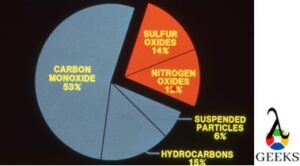Non-metals are chemical compounds which do not exhibit metallic lustre, hardness and electrical conductivity. There are seventeen elements in the periodic table that are classified as non-metals. Six of these non-metals belong to the noble gas family and are almost inert. Therefore, when talking about non-metals, we will focus on hydrogen, carbon, nitrogen, oxygen, fluorine, phosphorous, sulphur, chlorine, selenium, bromine and iodine.
- Carbon monoxide
- Carbon dioxide
- Carbon suboxide
- Sulfur dioxide
- Sulfur trioxide
- Phosphorous(III) oxide
- Phosphorous(V) oxide
- Nitric Oxide
- Nitrogen dioxide
- Dinitrogen pentoxide
- Chlorine dioxide
- Oxygen difluoride
Carbon Monoxide
It is one of the non metallic oxide examples of carbon. When graphite(an allotrope of carbon) is burned in a limited amount of oxygen, we get carbon monoxide. It has a linear shape with a triple bond between carbon and oxygen. Carbon monoxide can cause suffocation at high concentrations.
Carbon Dioxide
It is a colourless and non-flammable non metallic oxide. It is formed when carbon is burned in excess of oxygen. It is a greenhouse gas. It traps heat in the atmosphere. It is linear in shape with sp hybridized carbon having double bonds with oxygen atoms. It has a symmetric geometry.
Carbon Suboxide
It is a tear-stimulating gas with the chemical formula C3O2. It is an unstable gas produced by dehydration of malonic acid with phosphorous pentoxide. It is a linear molecule with four successive double bonds between carbon and oxygen atoms. It is stable at -78◦C.
Sulfur Dioxide
It is a toxic gas with a suffocating odour and chemical formula SO2. It burns slowly in oxygen, produces a blue flame, and reacts with water to form sulfuric acid. It has a bent shape with an sp2 hybridized sulphur atom. It is used as a food preservative and in wine making.
Sulfur Trioxide
It is a white crystalline solid with the chemical formula SO3. It is formed when sulfur dioxide is heated with oxygen; 2SO2 + O2 → 2SO3. It has a trigonal planar shape, and sulphur is sp2 hybridized. Sulphur trioxide is a strong lewis acid and accepts an electron pair from a lewis base.
Phosphorous(III) oxide
Phosphorous forms two common non-metallic oxides. Phosphorous(III) oxide is a white crystalline solid with the chemical formula P406. It is a poisonous gas and has a garlic-like odour.
Phosphorous(V) oxide
It is a non-metallic oxide of phosphorous with the chemical formula P4O10. It is formed when phosphorous is burned in excess of oxygen. It is used as a desiccant. When tetraphosphorous or P4 is burned with oxygen, it forms phosphorous(V) oxide. It is a poor oxidizing agent.
Nitric Oxide
It is one of the oxides of nitrogen with the formula NO. It is a free radical which dimerizes to form N2O2. It is responsible for acid rain and ozone layer depletion. Although it is a toxic pollutant produced by automobile engines, it plays an essential role as a neurotransmitter and signalling molecule.
Nitrogen dioxide
It is a non-metallic oxide example of nitrogen and oxygen with a chemical formula NO2. It is a reddish-brown, pungent and corrosive gas used to manufacture nitric acid and chemical explosives. It is formed by the combustion of fossil fuels(especially car fuels).
Dinitrogen pentoxide
It is a colourless non-metallic oxide of nitrogen and oxygen with the chemical formula N2O5. It is formed by the dehydrating nitric acid with phosphorous(V) oxide. It adopts two structures- it exists as salt in the solid-state and as a covalently bonded molecule in the gaseous state.
Chlorine dioxide
It is a non-metallic example of chlorine and oxygen with the chemical formula Cl2O. It is used to bleach paper, purify water and disinfect vehicles. It is a paramagnetic compound with an odd number of valence electrons. It is a reddish-yellow gas which decomposes into chlorine and oxygen in the presence of strong acids.
Oxygen difluoride
Oxygen difluoride or OF2 is an oxide of fluorine. It is prepared by the reaction of aqueous sodium hydroxide and fluorine; 2 F2 + 2 NaOH → OF2 + 2 NaF + H2O. It is a strong oxidizing and fluorinating agent. It has a strong odour and is poisonous. It is used as an oxidizer for jet propulsion systems. It has a bent structure with a bond angle of 103.2◦.
More Facts
Non-metals react with oxygen on heating to form non-metal oxides. In general, non-metallic oxides are acidic in nature.Non-metallic oxides dissolve in water to form acids. For example, sulfur trioxide dissolves in water to form sulfuric acid. SO3(g) + H2O(l)→ H2SO4(aq). Since non-metallic oxides are acidic in nature, they react with base and get neutralized; salt and water are the products.
Non-metallic oxide + Base → Salt + Water
Conclusion
This article explained twelve non-metallic oxide examples with their essential facts. We learnt about carbon monoxide, carbon dioxide, carbon suboxide, sulfur dioxide, sulfur trioxide, phosphorous(III) oxide, phosphorous(V) oxide, nitric oxide, nitrogen dioxide, dinitrogen pentoxide, chlorine dioxide and oxygen difluoride.

Hello, I am Sakshi Anand completed my Master’s in Chemistry. My area of specialization is Inorganic Chemistry. I am here to make chemistry easy and enjoyable to read. Complex ideas do not require complex language. I am an avid reader and enjoy researching intensively.
